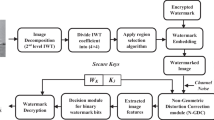Abstract
Transform-based techniques partially address challenges like robustness and the imperceptibility in image steganography. Such approaches, however, increase the memory requirement and reduce the quality of the cover image and hiding capacity. Moreover, the steganography is always coupled with cryptography to strengthen the confidentiality. This paper presents an adaptive hybrid method for image steganography procedure based on bit reduction and pixel adjustment using the fuzzy logic and integer wavelet transform technique. The fuzzy set theory provides powerful tools to represent and process human knowledge in the form of fuzzy if-then rules that can resolve difficulties in image processing arising due to the uncertainty of the data, tasks, and results. We apply a bit reduction algorithm to each byte of the data which are to hide in the cover image. This decreases the memory usage and increases the capacity. The embedding of the input text into the cover image distorts the cover image. Hence, to minimize the visual difference between the cover image and the text embedded image, an optimum pixel adjustment algorithm is applied to the text embedded image. Simulation results demonstrate the effectiveness of our proposed approach.













Similar content being viewed by others
References
Ahmad A, Paul A, Rathore MM (2016a) An efficient divide-and-conquer approach for big data analytics in machine-to-machine communication. Neurocomputing 174:439–453
Ahmad A, Paul A, Rathore MM, Chang H (2016b) Smart cyber society: integration of capillary devices with high usability based on cyber-physical system. Future Gener Comput Syst 56:493–503
Cao W, Han J (2012) Steganalysis on JPEG decompressed bitmaps revisited. In: 2012 Fourth International Conference on Multimedia Information Networking and Security (MINES), pp 878–881
Chan CK, Cheng LM (2004) Hiding data in images by simple LSB substitution. Pattern Recognit 37:469–474
Changa K, Changa C, Huangb PS, Tua T (2008) A novel image steganographic method using tri-way pixel-value differencing. J Multimed 3(2):37–44
Chen W (2003) A comparative study of information hiding schemes using amplitude, frequency and phase embedding. PhD thesis, National Cheng Kung University, Tainan, Taiwan
Grover N, Mohapatra AK (2013) Digital image authentication model based on edge adaptive steganography. In: 2013 2nd International Conference on Advanced Computing, Networking and Security (ADCONS), pp 238–242
Gupta MM, Knopf GK, Nikiforuk PN (1987) Computer vision with fuzzy edge perception. In: International Symposium on Intelligent Control, Philadelphia, USA, pp 271–278
Hou X, Zhang T, Xiong G, Wan B (2012) Forensics aided steganalysis of heterogeneous bitmap images with different compression history. In: 2012 Fourth International Conference on Multimedia Information Networking and Security (MINES), pp 874–877
Lai B, Chang L (2006) Adaptive Data hiding for images based on Harr discrete wavelet transform. Lecture notes in computer science, vol 319
Lillo J, Shih M (2008) Generalizations of pixel-value differencing steganography for data hiding in images. Fundam Inform 83(3):319–335
Paul A, Ahmad A, Rathore MM, Jabbar S (2016) Smartbuddy: defining human behaviors using big data analytics in social internet of things. IEEE Wirel Commun 23(5):68–74
Ramaiya MK, Hemrajani N, Saxena AK (2013a) Improvisation of security aspect in steganography applying DES. In: 2013 International Conference on Communication Systems and Network Technologies (CSNT), pp 431–436
Ramaiya MK, Hemrajani N, Saxena AK (2013b) Security improvisation in image steganography using DES. In: 2013 IEEE 3rd International on Advance Computing Conference (IACC), pp 1094–1099
Simmons GJ (1984) The prisoners’ problem and the subliminal channel. In: Proceedings of Crypto’83, pp 51–67
Tseng HW, Chang CC (2004) High capacity data hiding in JPEG-compressed images. Informatica 15(I):127–142
Valenzise G, Tagliasacchi M, Tubaro S (2013) Revealing the traces of JPEG compression anti-forensics. IEEE Trans Inf Forensics Secur 8(2):335–349
Wang K, Zhao H, Wang H (2014) Video steganalysis against motion vector-based steganography by adding or subtracting one motion vector value. IEEE Trans Inf Forensics Secur 9(5):741–751
Westfeld A (2001) F5a steganographic algorithm: high capacity despite better steganalysis. In: 4th International Workshop on Information Hiding, 25–27 April, pp 289–302
Wu N, Hwang M (2007) Data hiding: current status and key issues. Int J Netw Secur 4(1):1–9
Zayed HH (2005) A high-hiding capacity technique for hiding data in images based on K-Bit LSB substitution. In: The 30th International Conference on Artificial Intelligence Applications (ICAIA—2005), Cairo
Author information
Authors and Affiliations
Corresponding author
Ethics declarations
Conflict of interest
The authors declare that they have no conflict of interest.
Additional information
Communicated by M. Anisetti.
Rights and permissions
About this article
Cite this article
Shafi, I., Noman, M., Gohar, M. et al. An adaptive hybrid fuzzy-wavelet approach for image steganography using bit reduction and pixel adjustment. Soft Comput 22, 1555–1567 (2018). https://doi.org/10.1007/s00500-017-2944-5
Published:
Issue Date:
DOI: https://doi.org/10.1007/s00500-017-2944-5




